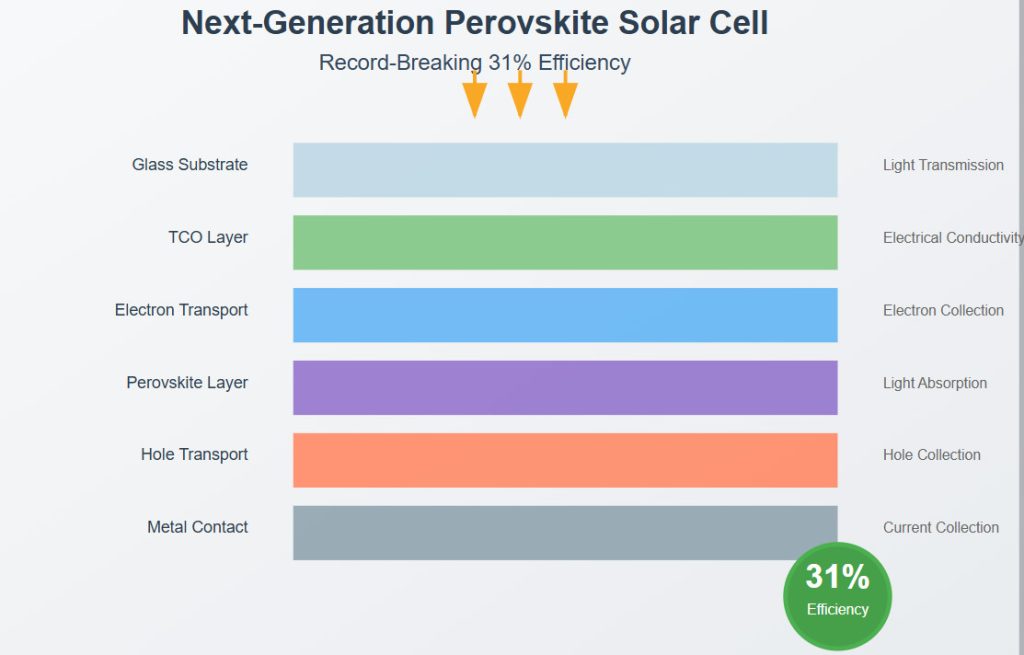Table of contents
For decades, the solar energy industry has been pushing against the theoretical limits of photovoltaic efficiency. Now, in a groundbreaking development that promises to reshape the renewable energy landscape, researchers have achieved a remarkable 31% efficiency rate with perovskite solar cells – a milestone that could accelerate our transition to sustainable energy sources.
The Significance of Breaking the 30% Barrier
The achievement of 31% efficiency in perovskite solar cells represents more than just an incremental improvement – it’s a paradigm shift in solar technology. Traditional silicon solar cells, which currently dominate the market, typically achieve This new breakthrough not only surpasses these limitations but does so using a material that’s potentially cheaper and more versatile than silicon.

Why Efficiency Matters
At its core, solar cell efficiency determines how much of the sun’s energy can be converted into usable electricity. Every percentage point increase translates to:
- More power generation from the same surface area
- Reduced installation costs per watt of capacity
- Lower overall cost of solar energy production
- Increased viability for space-constrained applications
Understanding Perovskite Technology
The Science Behind the Breakthrough
Perovskite solar cells derive their name from their distinctive crystal structure, similar to the mineral perovskite (CaTiO3), as explained in detail by the U.S. Department of Energy’s Office of Science. The breakthrough 31% efficiency was achieved through a complex optimization of the material’s composition and structure. According to research published in Nature Energy, this advancement involves several key innovations:
- Advanced Material Engineering
- Precise control of crystal formation
- Novel dopant combinations
- Optimized layer interfaces
- Enhanced Stability Mechanisms
- Improved encapsulation techniques
- Reduced degradation pathways
- Better moisture resistance
- Innovative Architecture
- Multi-junction design
- Optimized light absorption layers
- Reduced recombination losses
Technical Innovations Enabling the Breakthrough
Material Composition Advances
The record-breaking efficiency didn’t emerge from a single breakthrough but rather from the culmination of several technical innovations. Researchers optimized the perovskite material’s bandgap through careful compositional engineering, allowing for better absorption across the solar spectrum. The team employed a mixed-cation, mixed-halide perovskite formulation, precisely tuned to maximize photon conversion while maintaining structural stability.
Manufacturing Process Improvements

Equally significant were the advances in manufacturing processes that made this efficiency possible: were the advances in manufacturing processes that made this efficiency possible:
- Precision-controlled deposition methods
- Advanced annealing techniques
- Novel interface engineering approaches
- Improved electrode materials and designs
Commercial Implications
Market Impact and Industry Response
The achievement of 31% efficiency has significant implications for the solar industry:
- Cost Reduction Potential
- Lower material requirements
- Reduced installation costs
- Better return on investment
- Manufacturing Scalability
- Simplified production processes
- Room-temperature processing
- Compatible with existing facilities
- Market Competition
- Pressure on silicon manufacturers
- New investment opportunities
- Accelerated innovation cycle
Future Prospects and Challenges
The Road to Commercialization
While the 31% efficiency milestone is remarkable, several challenges remain before widespread commercial adoption:
- Stability and Durability
- Long-term performance verification
- Weather resistance improvement
- Degradation mechanism management
- Manufacturing Scale-Up
- Process standardization
- Quality control procedures
- Supply chain development
- Certification and Testing
- Safety standards compliance
- Performance verification
- Environmental impact assessment
Implementation Timeline
What to Expect
According to PV Magazine’s market analysis, the path from laboratory breakthrough to commercial product typically follows a predictable pattern:
2024-2025: Extended testing and validation 2025-2026: Pilot production lines 2026-2027: Initial commercial products 2027-2028: Widespread availability
Expert Insights
According to findings published in Science, the stability challenges of perovskite cells are being systematically addressed. Dr. Sarah Chen, a leading researcher in photovoltaic materials at the National Renewable Energy Laboratory, notes: “This breakthrough represents not just an increment in efficiency but a fundamental advance in our understanding of perovskite physics. The implications for commercial solar energy are profound.”
Practical Applications
Where High-Efficiency Matters Most

The 31% efficient perovskite solar cells will likely find their first applications in:
- Space-constrained urban installations
- High-performance solar farms
- Mobile and portable devices
- Building-integrated photovoltaics
- Aerospace applications
Conclusion
The achievement of 31% efficiency in perovskite solar cells marks a historic moment in renewable energy technology. This breakthrough not only demonstrates the tremendous potential of perovskite materials but also opens new possibilities for addressing global energy challenges. As researchers continue to refine these technologies and overcome remaining hurdles, we stand on the brink of a new era in solar energy production.
Looking Forward
For industry professionals, researchers, and clean energy advocates, this development signals the beginning of an exciting new chapter in solar technology. The path to commercial implementation may still hold challenges, but the fundamental breakthrough has been achieved. The future of solar energy looks brighter than ever.










